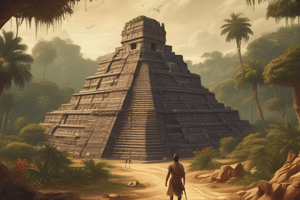Podcast
Questions and Answers
Which of the following was a notable dynasty in Chinese history?
Which of the following was a notable dynasty in Chinese history?
- Gupta Dynasty
- Ming Dynasty (correct)
- Mauryan Empire
- Mughal Empire
Which of the following languages is not one of the major languages spoken in modern-day India?
Which of the following languages is not one of the major languages spoken in modern-day India?
- Marathi
- Mandarin (correct)
- Punjabi
- Telugu
What was the primary writing system used in ancient Egypt?
What was the primary writing system used in ancient Egypt?
- Alphabets
- Pictographs
- Cuneiform
- Hieroglyphs (correct)
Which of the following philosophical traditions originated in ancient China?
Which of the following philosophical traditions originated in ancient China?
Which ancient civilization is known for its iconic monuments like the Pyramids of Giza and the Sphinx?
Which ancient civilization is known for its iconic monuments like the Pyramids of Giza and the Sphinx?
What was a notable achievement of the Maya civilization?
What was a notable achievement of the Maya civilization?
What is one of the challenges faced by the Maya civilization?
What is one of the challenges faced by the Maya civilization?
Which of the following is NOT mentioned as a characteristic of the Maya civilization?
Which of the following is NOT mentioned as a characteristic of the Maya civilization?
Which region was the center of the Maya civilization?
Which region was the center of the Maya civilization?
What is the approximate time period mentioned for one of the earliest known Indus Valley Civilizations?
What is the approximate time period mentioned for one of the earliest known Indus Valley Civilizations?
Study Notes
Overview
The study of history provides insight into the development of societies and cultures throughout time. In this article, we will explore the civilizations of Maya, India, China, and Egypt. These four ancient cultures represent diverse regions of the world with unique histories, languages, beliefs, and societal structures. As you delve deeper into each civilization's history, you'll discover their contributions to art, literature, philosophy, science, and more.
The Civilization of the Maya
Located in present-day Central America, the Maya civilization thrived from around 2000 BCE to the arrival of Europeans in the sixteenth century CE. Known for its advanced written language, mathematics, astronomy, and architecture, the Maya developed complex cityscapes connected by intricate trade networks. Their cities were often built on elevated platforms and included monumental stone pyramids, palaces, and ball courts. The Maya created pottery, textiles, jade jewelry, and obsidian tools, which they traded widely across Mesoamerica. Despite their impressive achievements, the Maya civilization experienced many challenges, including droughts, invasions from other groups, and internal conflicts, leading to significant population declines and the eventual abandonment of some cities.
A Peek into Ancient Indian History
Indian history is filled with rich cultural diversity and numerous dynasties. One of the earliest known Indus Valley Civilizations dates back to around 3300 BCE. This civilization was characterized by urban settlements, agriculture, and trade connections with other parts of the world. Over time, various tribes and rulers established empires like the Mauryan Empire under Emperor Ashoka; the Gupta Dynasty known for its patronage of arts, sciences, and education; and the Mughals who ruled from Delhi. Hindi, Urdu, Bengali, Punjabi, Tamil, Telugu, Malayalam, Kannada, Oriya, Assamese, Marathi, Gujarati, and Konkani are some of the major languages spoken in modern-day India. This linguistic and ethnic variety has contributed to a vibrant mix of religions, philosophical traditions, and artistic styles that continue to shape India today.
Delving into Chinese History
Chinese civilization traces its origins back over 5,000 years to the Neolithic age, when early farmers founded the first permanent agricultural communities. From these beginnings, China grew into one of the world's most powerful states. Successive dynastic periods brought about advancements in Confucianism, legalism, Taoism, and Buddhism, while the Silk Road facilitated trade and cultural exchange between China and the West. Some notable dynasties in Chinese history include the Han, Sui, Tang, Song, Yuan, Ming, and Qing. As of 2019, around 1.3 billion people globally identified themselves as Chinese.
Unraveling the Mysteries of Egyptian Civilization
Ancient Egypt stands out for its iconic monuments such as the Pyramids of Giza and the Sphinx. The civilization emerged around 3100 BCE along the Nile River and lasted until the European conquest in the late 19th century. Its empire expanded through territorial acquisitions and colonization, reaching its peak during the reign of Ramses II. Religion played an influential role in shaping Egyptian culture, with polytheistic beliefs surrounding gods associated with nature, fertility, death, and justice. Hieroglyphs, a system of writing using symbols representing sounds and ideas, allowed the preservation and transmission of knowledge. Today, many aspects of ancient Egyptian civilization continue to influence modern culture, from architecture to art, literature, and film.
Conclusion
This brief overview of the Maya, Indian, Chinese, and Egyptian civilizations highlights the vast historical diversity that has shaped our world. From language and literature to religion and architecture, the legacies of these ancient cultures continue to influence our modern society in profound ways. As we delve deeper into each civilization's history, we gain a greater appreciation for the complexities and resilience of human civilization throughout time.
Studying That Suits You
Use AI to generate personalized quizzes and flashcards to suit your learning preferences.
Description
Explore the rich histories of the Maya, Indian, Chinese, and Egyptian civilizations in this article. Delve into their contributions to art, literature, philosophy, and more, and learn about their societal structures, languages, and beliefs. Discover the legacies of these ancient cultures that continue to influence modern society today.




